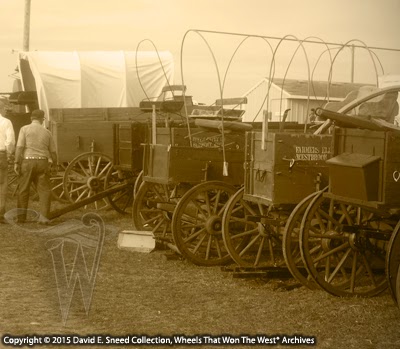The old barn wasdark, dusty, and full of cobwebs. It hadbeen ages since it was an active part of the family farm. Swallow and mud dobber nests dotted theinterior and sunlight pried its way through the slat board sides. As I walked across the loft floor, the oldplanks popped and groaned, warning me to step lightly. I stopped to survey the interior, finallyfixing my eyes on the back of the building. As my sight adjusted to the dim surroundings, I noticed a familiar shapepeering out from under a massive pile of loose hay. Pulling back the musty straw, I began touncover yet another nineteenth century survivor on wheels. Who was the maker? What history did it hold? Why had it been buried? Plenty of questions begged for answers butone fact was clear. This was more thanan old wagon. It was a reminder thatscarce pieces of early transportation history are still out there, waiting tobe discovered and worthy of being preserved for future generations.
To that point,we’re thankful to be adding a couple more original pieces to our collectionthis week. One is a small stage wagon –also referred to as a mail jerky – from California’s legendary gold country. Built on a Mountain Wagon frame, the aged structureis oozing with western character. (Forreaders primarily familiar with “farm-style” mountain wagons, this is adifferent design entirely – I’ll try and cover the distinctions in a laterblog). The other vehicle is an early,slip-reach running gear with a morphing bed/box that folds into multipleconfigurations. The folding box wasbuilt by the American Wagon Company and is one of only a handful or two we believeto have survived.
While each vehicleis from a different century, both represent hard-to-find, century-plus-oldpieces. To date, the Wheels That Won TheWest® vehicle collection includes examples from several dozen brands withdocumented histories spanning every decade from the 1870’s through the 1940’s.
If you’ve beenreading this blog for any length of time, you know that the process of locatingand studying vintage wagons has long been a passion of mine. It’s a rewarding pastime highlighted bycountless stories and remarkable finds. For every find, though, there are countless dry runs and falseleads. Two decades ago, as I began toearnestly analyze early wagons and western vehicles, I couldn’t have imaginedhow much there would be to learn. Similarly, I never cease to be amazed at the amount of misinformationthat can be heard and seen today. I’ve cometo believe that the near-endless number of speculative statements, personalopinions, misconceptions, and outright untruths may be the biggest obstacle foranyone sincerely wanting to understand period wood-wheeled vehicles.
My recommendation for avoiding thesepitfalls goes straight to the heart of the definition of ‘research.’ Modern dictionaries describe this term asbeing “a careful or diligent search.” Thatmeans you probably shouldn’t believe everything you hear offhand and certainlyshould be cautious about placing too much credibility in every search of topicson the internet.
 |
| The process of closely examining and documenting features on numerous original wagons can play an important role in sustainable research. |
Case in point… Not long ago, I noticedan auction where a wagon was represented as an early 1800’s piece. It was not. The supposed history of the vehicle was equally incorrect. Likewise, elements of the vehicle weremismatched and not original. How did Iknow? First of all, the purported dateof the piece was not in sync with multiple design standards and constructionmethods on the wagon. As I’ve sharedbefore, over the years, wagon makers often changed methods of manufacturing asthey repeatedly looked for ways to create better products. Recognizing these variables is important whenassessing wood-wheeled transportation.
Secondly, the wagon brand was one I knewhad not been manufactured until after the turn of the 20th century. The original maker stenciling and stamping ondifferent parts of the wagon made this point even more obvious. Finally, I’ve shared over and over that everypart of a period vehicle has a story to tell. Part of my mission in these situations is to study details to determinewhat information can be gleaned from every part. These types of comprehensive reviews have away of uncovering inconsistencies in a vehicle. After examining thousands of these rolling workhorses, I’ve noticed anumber of patterns. The experience hasmade it easier to know where to look and what to look for. In this particular auction, it was eventuallylearned that the well-meaning seller had briefly looked at one source on theinternet and, based on that single (unreliable) source, had made statementsthat left his credibility in question.
At the end of the day, there is a greatdeal of pride and satisfaction in knowing exactly what a particular piecerepresents. If you’re looking atpurchasing a period vehicle, don’t be afraid to dive in, ask plenty of questions,and insistent on documentation to support historical assertions. Regrettably, quick assumptions can leave aless than positive feeling for both parties in a transaction.
Twenty years ago, there was a reasonthat generalizations and best guesses were made about many old wagons andwestern conveyances. At the time, almostno information on individual brands could be found in a centralizedsource. As a result, not as much studyhad taken place. We knew little aboutperiod design standards and even less about construction variations among themyriad of different manufacturers. Today, information is more prevalent but still needs to be properlyvetted to help insure its reliability.
Please Note: As with each of our blog writings, all imagery and text is copyrighted with All Rights Reserved. The material may not be broadcast, published, rewritten, or redistributed without prior written permission from David E. Sneed, Wheels That Won The West® Archives.
Please Note: As with each of our blog writings, all imagery and text is copyrighted with All Rights Reserved. The material may not be broadcast, published, rewritten, or redistributed without prior written permission from David E. Sneed, Wheels That Won The West® Archives.